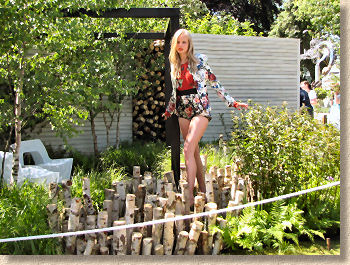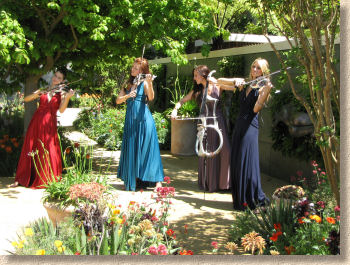Chelsea Flower Show 2010
So we enter a new age at the RHS Chelsea Flower Show , a post-Marshalls era, when the sponsor of the past three years has been supplanted by investment adviser, M&G. Yes: the money men are back and splashing it about as though there'd never been a meltdown of the banking sector.
While they may not be headlining the annual floral fiesta, Marshalls were still in evidence, and nowhere more prominently than in Mark Gregory 's garden for The Children's Society , which was aimed at truculent teenagers, offering them a fantastic (in the literal sense of that overused word) garden to blithely ignore and completely fail to appreciate, with a jungle-style hangout hut replete with ample horizontal lounging potential around a central firepit, a wood-fired pizza oven attended by scooter boy Jamie Oliver, and a swirling plunge pool for their empty beer cans and overfull bladders. They would certainly never notice the truly wonderful stone used to form the stepping stones and surface over which they could drag their feet.
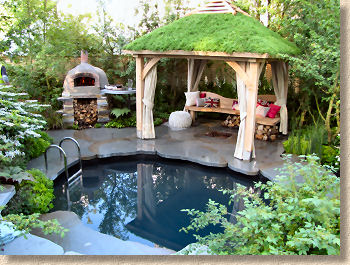

Huge, interlocking organic shapes, flame textured and water-cut 75mm thick slabs of Lancashire's finest Scout Moor stone, each weighing half-a-tonne or more, the cool blue-grey and honey-buff tones providing a superb backdrop to some very subtle planting. I had no doubt that this was a Gold Medal garden, and one that is very well deserved, especially for its use of native stone.
Just across the avenue, Mark had also contributed as a contractor to Tourism Malaysia 's Gold Medal garden, designed by druggist, James Wong and David Cubero of Amphibian Designs . This garden featured another classic native stone, yer actual Portland Limestone in 100mm thick rectangular slabs as stepping stones set amongst a slice of rainforest. On what was the hottest day of the year so far, this was one cool looking garden, with the richest green large-leaved planting providing desperately needed shade while the barely cream tones of the Portland stone emitted a chilled aura of calm and quiet.
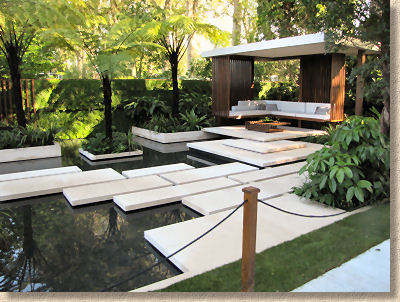
The Cancer Research UK garden was another Gold medal winner despite having the most impossible pathway at the show. Pitch-faced sleepers of dark granite laid transversely leading into the garden between a grove of slender birch trees underplanted with green and white woodland flora. As a deterrent paving, it was wonderful, but you'd struggle to get the lawn mower across it. I couldn't figure out why such a rugged and intractable pathway was used within what was otherwise a splendidly serene setting. Was there some hidden message? Or was it just some leftovers from another project?
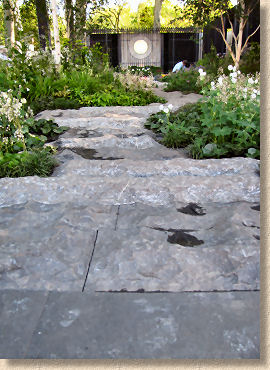
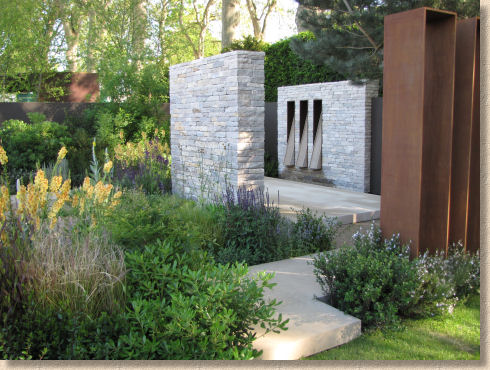
For the second year running, the Daily Telegraph won Gold and Best in Show. I'm not the biggest fan of so-called 'contemporary' gardens, but there is no denying that Andy Sturgeon's design effortlessly blends all the required components into a deliciously relaxing patch. Even the rusty steel box-sections contributed to the overall effect, but for me, the real eye-catcher was the standalone walls, the rearmost of which formed the requisite water feature. I couldn't find anyone who knew for certain the origin of the stone, but if it's not French limestone, it's a bloody good copy.
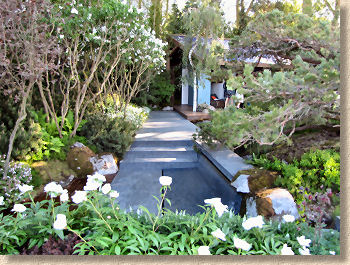
Some of the biggest stone on show could be found in the Kebony Naturally Norway garden. Maybe the sheer scale of some of the granite slabs had persuaded the judges to award just a Silver Gilt medal, but I loved the grandeur of the rectangular slabs of dark blue-grey Scandinavian granite which had been used to form a combined path with steps and a disappearing-into-a-joint water feature all of which contrasted sharply with very naturalistic planting.
If there was an award for most eye-catching hard-landscape feature, it would have to go to the Victorian Aviary Garden from South Lakes Hotels . The Maggy Howarth designed peacock mosaic formed from Lakeland pebbles and slate was simply stunning, although the relatively understated planting explains why the judges only saw fit to part with a Silver medal. Ice blue Lakeland slate was used to form copings for the low limestone walls and the paving of the raised platform which carried the ornate aviary-cum-tea room.


The last of the big Show Gardens that deserves a mention is the Peoples' Award winning M&G Garden . It's very much a traditional British garden, and that's what people like: gardens they can envisage at their own home. There's a gradation of planting from small specimen wonders to medium-sized trees, with a central rose-hugged pergola-cum-gazebo looking over a sandstone edged circular pool and simple but stunningly effective curved paths constructed from longitudinally laid reddish-brown clay pavers that teasingly draw the eye into the heart of the garden. It's a deserving winner of the Peoples' Award – it might not be cutting-edge or trendy or avant-garde, but it's the garden most of us would choose to sit in all summer long.
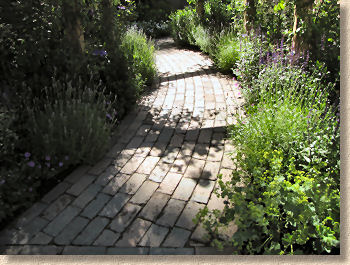
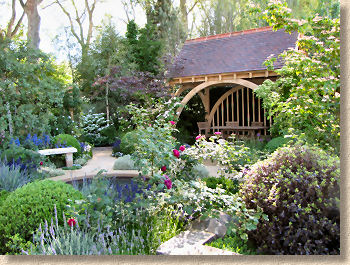
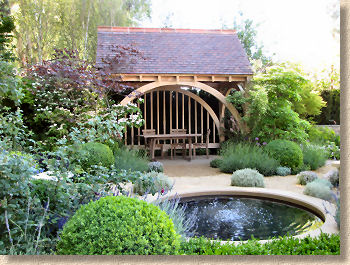
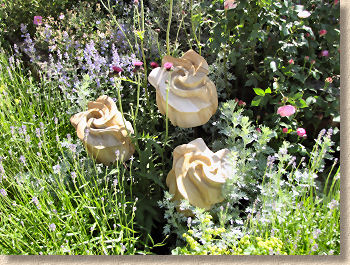
On to the Urban Gardens and I'll start with the one that was mentioned in a News item on this website a couple of weeks back. The John Joseph Mechi Garden celebrated the 150th anniversary of the RABI and featured engraved linear paving provided by Global Stone . I was pleasantly surprised by this small patch of a garden. The paving, laid transversely, blended well with the whole and the engraved motif, which can sometimes add a dash too much of tweeness to any garden, was mercifully simple and understated. The woven willow hedging was great fun and it comes as something of a surprise to see a very pleasant garden rewarded with a paltry Bronze medal.
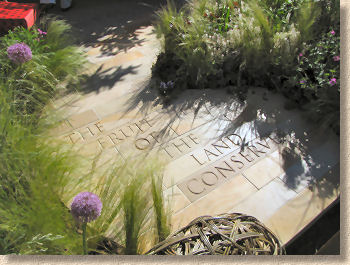
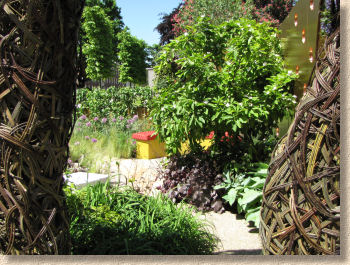
Much was made of David Domoney's Ace of Diamonds garden, but it was the totally unnecessary showbiz stunt of using a million quid's worth of precious stones in the garden, rather than the garden itself, that was the reason for all the attention. The geologist in me loved the use of geodes at one end of the garden, while the aesthete part of my nature loathed the tacky silver and gold path. It wasn't the worst garden on show, but it should count itself lucky to be heading off home with a Bronze.
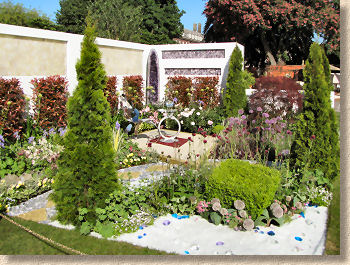
A garden I really did like was that by the University of Worcester. It was simple and elegant and exactly what an urban garden should be: an ideal balance of home and horticulture, enough greenery to qualify as a garden but plenty of space for relaxing and entertaining. I particularly loved the use of coloured glass panels in the shade-providing pergola, which cast their tinted light onto the uber-cool blue-grey limestone linear paving below, bringing an ever-changing kaleidoscope effect to the ideal 'chilling out' space. Silver-Gilt is well deserved.
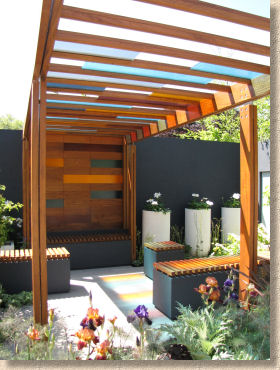
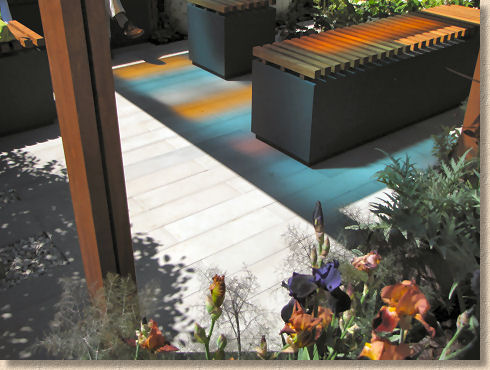
Bradstone were here again, as supporters of the Chris Beardshaw Mentoring Scholarship project, which appeared last year. Strangely, it looked like the same garden elements from last year albeit ever-so-slightly rearranged. Other than a dozen or so concrete flagstones forming a gate-to-seat straight line path, I couldn't really see what else Bradstone had contributed.
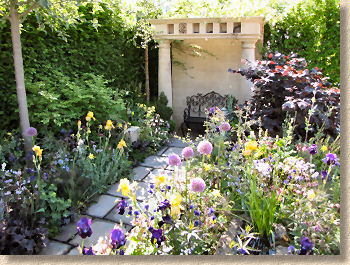
I'd love to be able to praise the Growing World Class Talent Garden put together by UK Skills , which promotes the horticultural and landscaping trades (amongst others) to young apprentices, and enters the best of them into competition with other nations around the world. Sadly, I just couldn't see a solid display of skill despite three or four visits to the garden throughout the day. There was no sense of theme and although individual elements, such as the brickwork or stonemasonry, revealed obvious talent, the pieces didn't seem to sit together comfortably. I couldn't (and still can't) decide whether it was a case of trying to show off too much in too small a space or whether it just needed someone with an overall vision to pull all the components together. Silver is a generous reward. I've no doubt the young 'uns who worked on the garden deserve it for their efforts but a more considered and competent design could have nudged them up to a Silver Gilt.
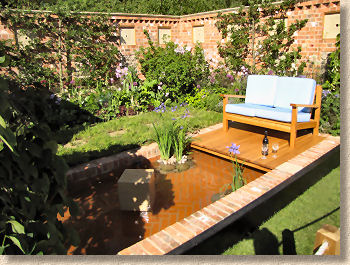
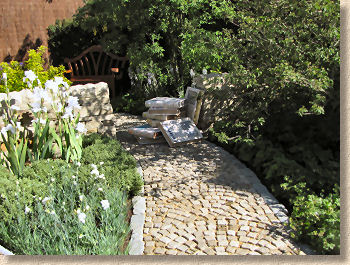
The Dyslexia Garden warrants a brief mention if only for the sett work (and the fact that the son and heir is just about as dyslexic as it's possible to be without falling over). The sett paving wasn't brilliant, with wandering edges and non-existent jointing, but this wasn't helped by being a prime example of a garden where the theme has overridden any consideration of functionality. Having a pile of oversize books obstructing a path strewn with lettered building blocks may be considered by some as a wonderful metaphor for the condition, but it makes for a poor garden, reflected in the award of just a Bronze.
As midday approaches and the heat becomes unbearable, it's time to head for the partial shade and relative cool of the Courtyard gardens at Ranelagh. These tiny plots usually offer the best of Chelsea and allow new blood to sup from the Chelsea Chalice without becoming intoxicated with it all. Many visitors speak of gaining more enjoyment from the handful of tiny gardens at Ranelagh than from the big show gardens on Main Avenue and this seems to stem from the approachability and personality of the smaller plots which strikes a chord with the everyday gardener. While the show gardens may illustrate what gardening heaven may be like for the rich and powerful few, the Courtyard gardens show what gardening means to the vast majority of us, what we can realistically achieve and how we can find fun and pleasure in the smallest space. This intangible quality sometimes escapes the beady-eyed judging.
The winner of the Peoples' Award for best small garden is an excellent example of this attitude. Deemed worthy only of a Silver by the esteemed judges, the hoi-polloi fell in love with the realism and humour of the Rhubarb Crumble and Custard Garden by Welcome to Yorkshire. It's a daft idea, admittedly, and there's probably a huge dollop of extra-thick nostalgia in the public vote, but it's an idea that tickles as it entertains. The hard-landscaping was very Yorkshire: a trail of yellow custard Sedums leads from the oaken spoon that sits atop new sawn yorkstone paving across reclaimed gritstone setts to the blue bath filled with more sedum and the essential rhubarb. A drystone wall of freshly cropped millstone grit represents the crumble topping, and it's all held together by what might be considered typical northern garden planting. Lovely!
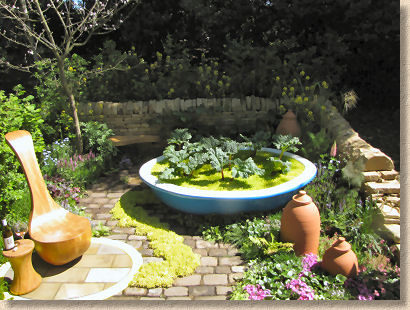
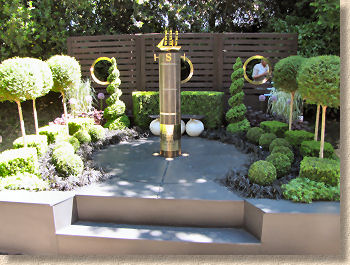
The memorial Garden for Capt RF Scott , him of the Antarctic, featured a brass sculpture representing the South Pole centred in a sectional slate circle engraved with a map of the southern polar region. It's a fairly typical memorial garden, and will serve its purpose well when it moves to its permanent home in Cardiff, from where Scott sett forth on June 15th 1910 aboard SS Terra Nova. I mention it here because it's yet another example of how water-cutting of stone has developed so rapidly in the last few years, and we are now able to etch and carve detail as lucid and eloquent as this into a notoriously awkward material.
My favourite Courtyard garden also featured water-cut stone, although you'd hardly notice it. The Global Stone Bee Friendly Garden is, as you should be able to guess, aimed at promoting a garden for bees. The rear wall is clad with dark indigo Blaenau slate, etched with the sobering warning from Einstein that, " If the bee disappeared off the surface of the globe then man would have only four year's of life left ". The barely noticeable water-cut stone forms the paving: concentric bands of polished sandstone separated by 50mm of so, lain over a honed black limestone. I wish the limestone had been given some other texture to emphasise its natural origin because those 40-50mm wide bands might as well be blackboard paint: the character of the stone can't make itself felt in such small doses.
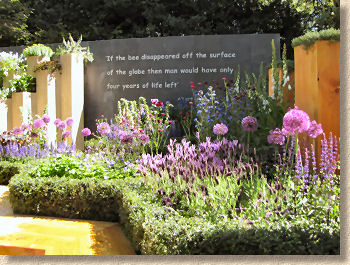
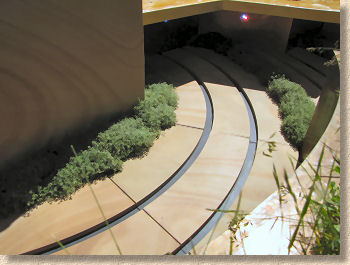
But for once, it's the rest of the garden that makes this my favourite. The combination of all-natural hard surfaces: golden sandstone, sombre slate, honey-hued wood like giant pencil blanks and a copper water feature, with luscious purple and green planting of many of my personal cottage-garden favourites such as salvia and agastache, alliums, lavender and campanulas. The honeycomb hexagon appears throughout, in the angle of the wooden benching and in the form of the water fountain. As I said to the designers, Janey Auchincloss and Paul Hammond, I could quite happily have stayed there and allowed it to pleasure my eyeballs for the rest of the day. Brilliant!
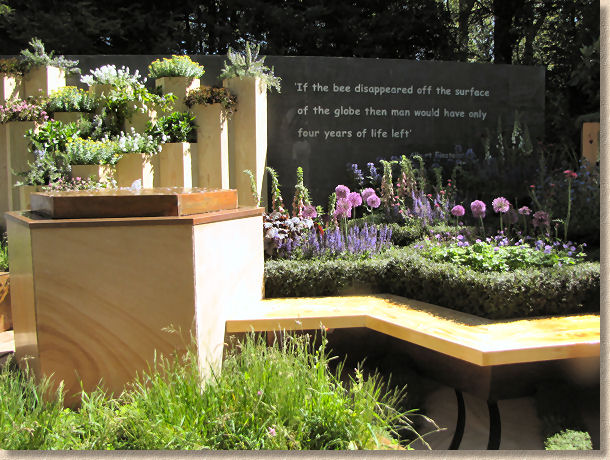
So, what will be the abiding memories of Chelsea 2010? There was a lot of green in the show gardens, and some of the ostentation of previous years seems to have been packed away for the time being. The presence of a few hard-landscaping suppliers (Global Stone, Marshalls, Bradstone) was low-key and I hope this is a temporary state of affairs. As I seem to say every year, I know that Chelsea is about gardens and plants, but without paving and hard-landscaping, a garden is just a field. Let's hope 2011 sees a stronger, more confident presence from the hard-landscaping trades.
In the meantime, here's some of the other pretty flowers on display at Chelsea 2010.....

